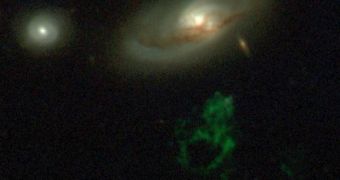A team of astronomers announces the discovery of a very rare type of cosmic structure, a dead quasar, in a galaxy located close to the Milky Way. Very few space bodies of this type have been discovered until now.
Quasi-stellar radio sources (quasars) are the most luminous objects in the Universe, and are essentially energetic and distant galaxies that have a very active galactic nucleus, usually powered up by a supermassive black hole.
The new investigation evidenced that the nearby quasar was blown out like a candle, the research team says. This phenomena took place some time in the last 70,000 years or so, the scientists estimate.
Given that the dimming process started with the “central lights” of the galaxy, it stands to reason that the black hole at the core might have had something to do with this.
Astrophysicists believe that analyzing the new object may provide additional insight into how the dark behemoths influence and regulate the growth and evolution of galaxies, Wired reports.
“This is the best view we will ever have of the host galaxy of a quasar. It’s the nearest one to us, and the quasar is dead,” explains Yale University astrophysicist Kevin Schawinski.
He is the lead author of a new paper detailing the findings, which appears in the October 26 online issue of the esteemed scientific publication Astrophysical Journal Letters.
The expert is also renowned for having co-founded the crowd-sourced science project Galaxy Zoo. He says that the key to understanding how black holes influence galaxy is a process called accretion.
This takes place as supermassive black holes gulp up gas and dust from their surroundings. The matter does not fall directly in the structure, but spins in a disk called the accretion disk.
Here, friction forces cause the materials to heat up, and release jets of radiation. Gas, for example, is heated until it glows white in images.
“Accretion transforms the darkest objects in the Universe into the brightest. It’s like the final scream before it disappears forever below the event horizon,” says astronomer Chris Done, who was not a part of the new investigation.
Done is an expert in black holes based in the United Kingdom, at the University of Durham. He says that astronomers can now use the glowing green gas clouds called Hanny’s Voorwerp to study how galaxies are influenced by black holes.
Some 45,000 to 70,000 light-years away from the Voorwerp, experts found a dim galaxy called IC 2497, which they say may be the remnants of an old quasar. This is the only way to explain why Voorwerp looks the way it does.
“We would have never found the nearest quasar to us, this system that will ultimately teach us so much about black holes and galaxies and how they evolve together, if it wasn’t for citizen science and the Internet,” says Schawinski about Galaxy Zoo.
“It’s so much cooler than anything we could have imagined,” he adds. The conclusion of the research was that the quasar in IC 2497 shut down less than 70,000 years ago.
This left the Voorwerp only a shadow of its former self, but also a testament of the brilliance the past active galaxy must have had. Astronomers estimate that it was 100 to 10,000 times brighter than it is today.

 14 DAY TRIAL //
14 DAY TRIAL //